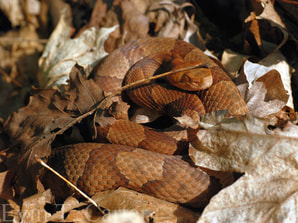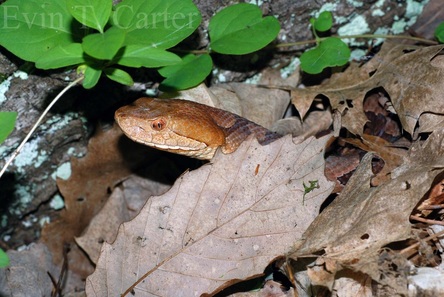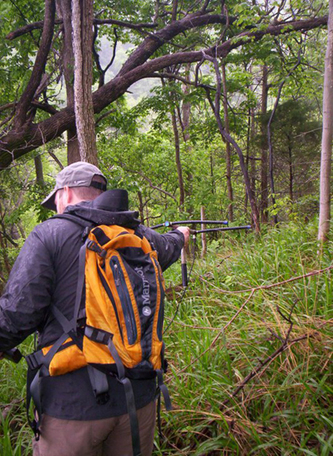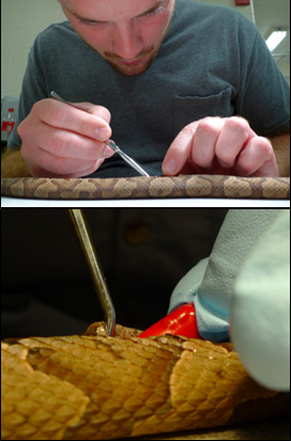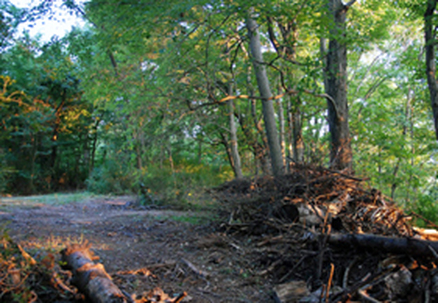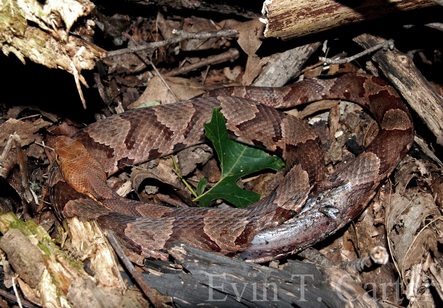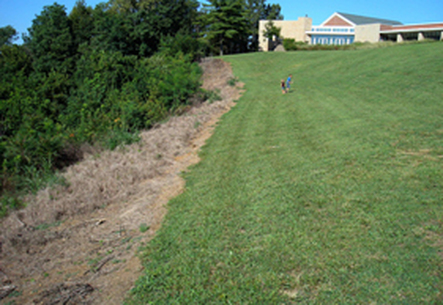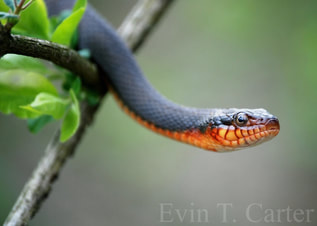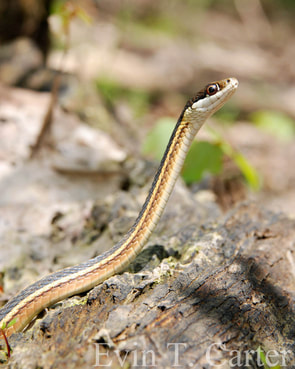SNAKE RESEARCH
|
Copperhead ecology and evolution
I have studied copperhead (Agkistrodon contortrix) ecology for over 10 years in projects ranging from impacts of invasive plants on thermoregulatory efficiency to the influence of roads on physiological stress response. We have also examined patterns of gene flow in eastern copperheads (and parthenogenesis). One goal of the project was to determine conservation status and relative isolation of Midwest populations. Copperheads are predominantly associated with two distinct regions in the Midwest that include rocky canyons and gorges to the east and oak-hickory ridges to the west. Populations inhabiting canyons and gorges appear more isolated and occur naturally at low density, whereas populations in oak-hickory forests are more contiguous and occur at much higher densities, while also differing in reproductive ecology in a manner that does not reflect thermal environments, climate, or fine-scale resource availability. This suggests that eastern populations are subject to increased effects of drift or that broader-scale selection has occurred at the 'landscape' level. |
Representative publications (copperhead ecology and evolution):
Carter, ET, MJ Ravesi, BC Eads, & BA Kingsbury (2016) Invasive plant management creates ecological traps for snakes. Biological Invasions 19(1): 443-453. (Link)
Carter, ET, MJ Ravesi, BC Eads, & BA Kingsbury (2015) Exotic invasive plants alter thermal regimes: Implications for management using a case study of a native ectotherm. Functional Ecology 29(5): 683-693. (Link)
Owen, Dustin, ET Carter, ML Holding, IT Moore, & K Islam (2014) Roads are associated with a blunted stress response in a North American pit-viper. General and Comparative Endocrinology 202(1): 87-92. (Link)
Carter, ET, O Attum, BC Eads, AS Hoffman, & BA Kingsbury (2014) Reducing the potential for human-snake encounters in a recreational park. Human-Wildlife Interactions 8(2): 158-167. (cover article) (RG Link)
Jordan, MA, N Perrine-Ripplinger, & ET Carter (2014) An independent observation of facultative parthenogenesis in the copperhead (Agkistrodon contortrix). Journal of Herpetology 49(1): 118-121. (Link)
Carter, ET, MJ Ravesi, BC Eads, & BA Kingsbury (2016) Invasive plant management creates ecological traps for snakes. Biological Invasions 19(1): 443-453. (Link)
Carter, ET, MJ Ravesi, BC Eads, & BA Kingsbury (2015) Exotic invasive plants alter thermal regimes: Implications for management using a case study of a native ectotherm. Functional Ecology 29(5): 683-693. (Link)
Owen, Dustin, ET Carter, ML Holding, IT Moore, & K Islam (2014) Roads are associated with a blunted stress response in a North American pit-viper. General and Comparative Endocrinology 202(1): 87-92. (Link)
Carter, ET, O Attum, BC Eads, AS Hoffman, & BA Kingsbury (2014) Reducing the potential for human-snake encounters in a recreational park. Human-Wildlife Interactions 8(2): 158-167. (cover article) (RG Link)
Jordan, MA, N Perrine-Ripplinger, & ET Carter (2014) An independent observation of facultative parthenogenesis in the copperhead (Agkistrodon contortrix). Journal of Herpetology 49(1): 118-121. (Link)
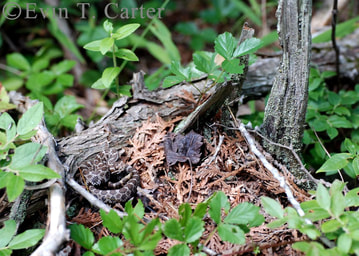 Neonate Massasauga, Grayling, MI
Neonate Massasauga, Grayling, MI
Thermoregulation, spatial ecology, and conservation of imperiled Massasaugas
Countless resources are devoted to habitat management for conservation purposes, but we still have relatively little understanding of how most wildlife respond to these efforts and thus extremely limited information on their potential success. This is especially true for time scales relevant to population recovery and for cryptic species such as pit-vipers, which often occur naturally at low density. For ectotherms, even slight modifications to habitat structure can be expected to generate meaningful responses, while also offering unique opportunities to examine resource selection theory at a deeper level. Recently listed as Threatened under the US Endangered Species Act, Massasaugas (Sistrurus catenatus) are at the center of major conservation management efforts. We have been investigating behavioral and physiological responses to experimental clear-cutting and fire in northern Michigan, expanding on radiotelemetry work beginning in 2006. This work has also generated several side projects, including the effects of the now widespread snake fungal disease (Ophidiomyces ophiodiicola) on spatial ecology and behavior. The work is being carried out with, among others, Sasha Tetzlaff, Mike Ravesi, & Bruce Kingsbury.
Countless resources are devoted to habitat management for conservation purposes, but we still have relatively little understanding of how most wildlife respond to these efforts and thus extremely limited information on their potential success. This is especially true for time scales relevant to population recovery and for cryptic species such as pit-vipers, which often occur naturally at low density. For ectotherms, even slight modifications to habitat structure can be expected to generate meaningful responses, while also offering unique opportunities to examine resource selection theory at a deeper level. Recently listed as Threatened under the US Endangered Species Act, Massasaugas (Sistrurus catenatus) are at the center of major conservation management efforts. We have been investigating behavioral and physiological responses to experimental clear-cutting and fire in northern Michigan, expanding on radiotelemetry work beginning in 2006. This work has also generated several side projects, including the effects of the now widespread snake fungal disease (Ophidiomyces ophiodiicola) on spatial ecology and behavior. The work is being carried out with, among others, Sasha Tetzlaff, Mike Ravesi, & Bruce Kingsbury.
Representative publications (massasauga ecology and conservation)
Tetzlaff, SJ, ET Carter, MJ Ravesi, BA DeGregorio, & BA Kingsbury (2017) Influence of resource manipulation on male rattlesnakes in a challenging environment: To forage, mate, or thermoregulate? Ecology and Evolution 7(16): 6606-6613. (Link)
Tetzlaff, SJ, MJ Ravesi, MC Allender, ET Carter, BA DeGregorio, & BA Kingsbury (2017) Snake Fungal Disease affects behavior of free-ranging massasauga rattlesnakes (Sistrurus catenatus). Herpetological Conservation and Biology. (Link)
Tetzlaff, SJ, ET Carter, MJ Ravesi, BA DeGregorio, & BA Kingsbury (2017) Influence of resource manipulation on male rattlesnakes in a challenging environment: To forage, mate, or thermoregulate? Ecology and Evolution 7(16): 6606-6613. (Link)
Tetzlaff, SJ, MJ Ravesi, MC Allender, ET Carter, BA DeGregorio, & BA Kingsbury (2017) Snake Fungal Disease affects behavior of free-ranging massasauga rattlesnakes (Sistrurus catenatus). Herpetological Conservation and Biology. (Link)
Extended leaf phenology of exotic shrubs and impacts on hibernation and acclimation in North American pit-vipers
|
Many exotic invasive plants exhibit extended growing seasons compared to their native counterparts. Previous work demonstrates that this can modify thermal regimes around snake hibernacula, potentially altering ingress and egress as well as an ability to acclimate. Current work attempts to better understand the mechanisms that govern emergence from hibernacula in many North American pit-vipers and how exotic plant invasions affect physiology and behavior during spring and fall transitional periods.
|

Temperature at hibernacula dominated by native shrubs (grey) and exotic Privet and Bush Honeysuckle (black). Inset: expected Te assuming full leaf-out had already occurred. Horizontal lines represent upper and lower thermal set points for copperheads. See Carter et al. 2015, Functional Ecology.
|
Representative publications (exotic plant impacts on ectotherms):
Carter, ET, BC Eads, & BA Kingsbury (2015) Exotic invasive plants alter thermal regimes: Implications for management using a case study of a native ectotherm. Functional Ecology 29(5): 683-693. (Link)
(more to come soon)
Carter, ET, BC Eads, & BA Kingsbury (2015) Exotic invasive plants alter thermal regimes: Implications for management using a case study of a native ectotherm. Functional Ecology 29(5): 683-693. (Link)
(more to come soon)
Modelling snake movement in temporally dynamic habitats
Null models should capture all but the process(s) being studied. Surprisingly, spatially explicit analyses of animal movements (eg, paths, trajectories) rely largely on random walks or, at best, slightly more complex biased walks. At their simplest, these models take telemetry data (x,y coordinates), calculate turn angles and step lengths, and simulate new paths by randomizing the observed values. These represent appropriate null models only if the hypothesis is that something affects movement. One recently developed model addresses many of these issues by incorporating habitat bias (ie, preference), but it too fails to account for the innate behaviors of most snakes and other temperate climate ectotherms... I'll leave it at that for now, but you can check out a recent presentation instead.
Null models should capture all but the process(s) being studied. Surprisingly, spatially explicit analyses of animal movements (eg, paths, trajectories) rely largely on random walks or, at best, slightly more complex biased walks. At their simplest, these models take telemetry data (x,y coordinates), calculate turn angles and step lengths, and simulate new paths by randomizing the observed values. These represent appropriate null models only if the hypothesis is that something affects movement. One recently developed model addresses many of these issues by incorporating habitat bias (ie, preference), but it too fails to account for the innate behaviors of most snakes and other temperate climate ectotherms... I'll leave it at that for now, but you can check out a recent presentation instead.
Eastern Copperhead Spatial Ecology and Habitat Management Impacts
|
Spatial Ecology of Copperheads
Radiotracking copperheads
in southern Indiana Implanting a radiotransmitter in a copperhead.
|
Managed Habitats as Ecological Traps
Forest gap after being dozed during management activities in a natural resource area. The gap was used to discard and compact exotic vegetation clippings following large-scale removal efforts by land managers. These efforts were successful in reclaiming basking habitat for ectotherms, but subsequent treatments were not well-planned by managers, resulting in high mortality (particularly for copperheads).
Copperhead killed following repeated mechanical treatments to remove exotic plants. Initial removal efforts occurred in the spring. Snakes responded to removal rapidly, but, unfortunately, additional mechanical treatments occurred that summer, killing multiple radio-tagged snakes as well as box turtles.
Mechanical and herbicide treatments to control exotic vegetation at a park in southern Indiana. Several snakes and box turtles were killed in the process.
|
Conservation management of wetland reptiles
|
I led population monitoring efforts for the imperiled Copper-bellied Watersnake (Nerodia erythrogaster neglecta - now considered a distinct population segment of plain-belled watersnakes, N. erythrogaster) for USFWS for several years. These efforts have been valuable in conservation management of Indiana populations, but we have only scratched the surface with these data!
I am also collaborating with Bryan Eads, Lindsey Hayter, and Bruce Kingsbury in designing and testing various road-crossing designs to mitigate road mortality and increase habitat connectivity for Copper-bellied Watersnakes and other wetland reptiles. |
Eastern Ribbonsnake (Thamnophis sauritus)
|
